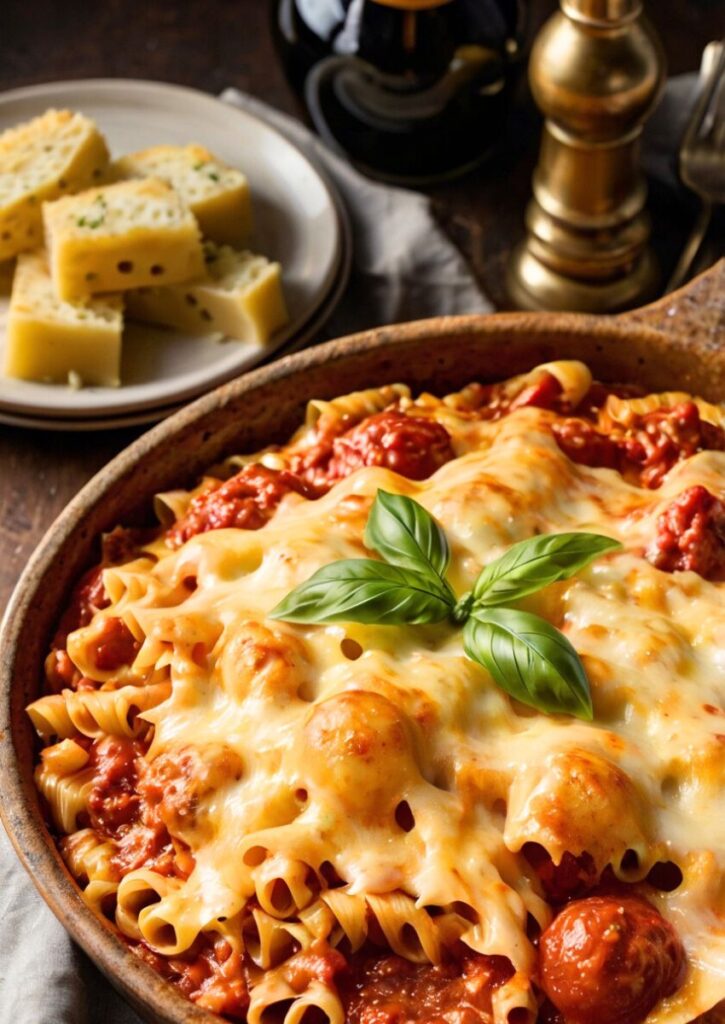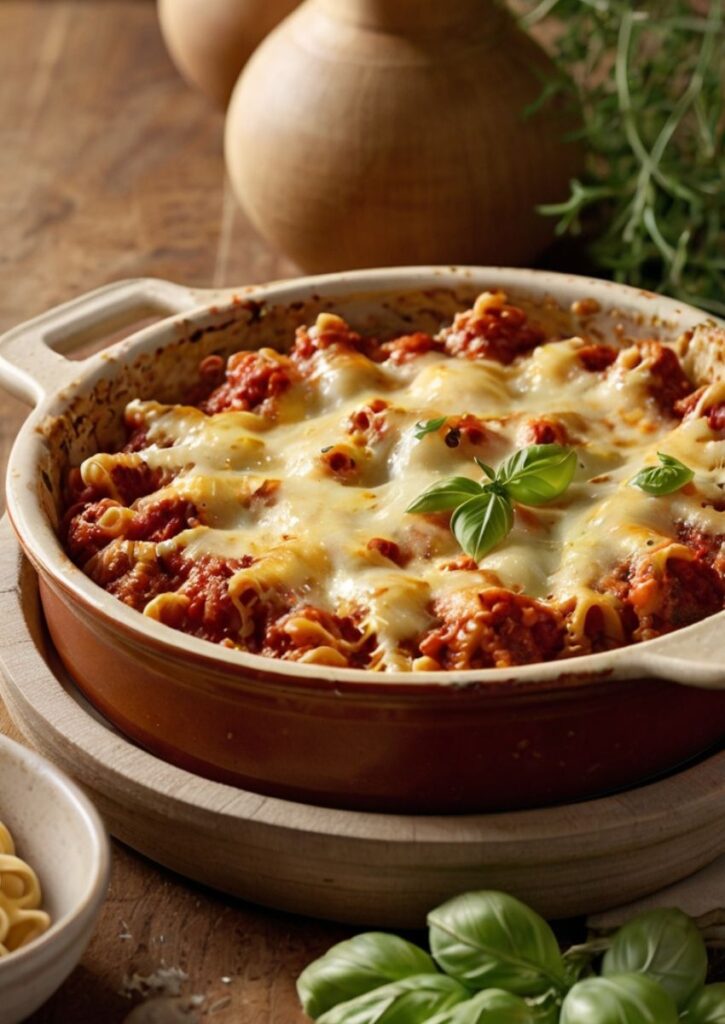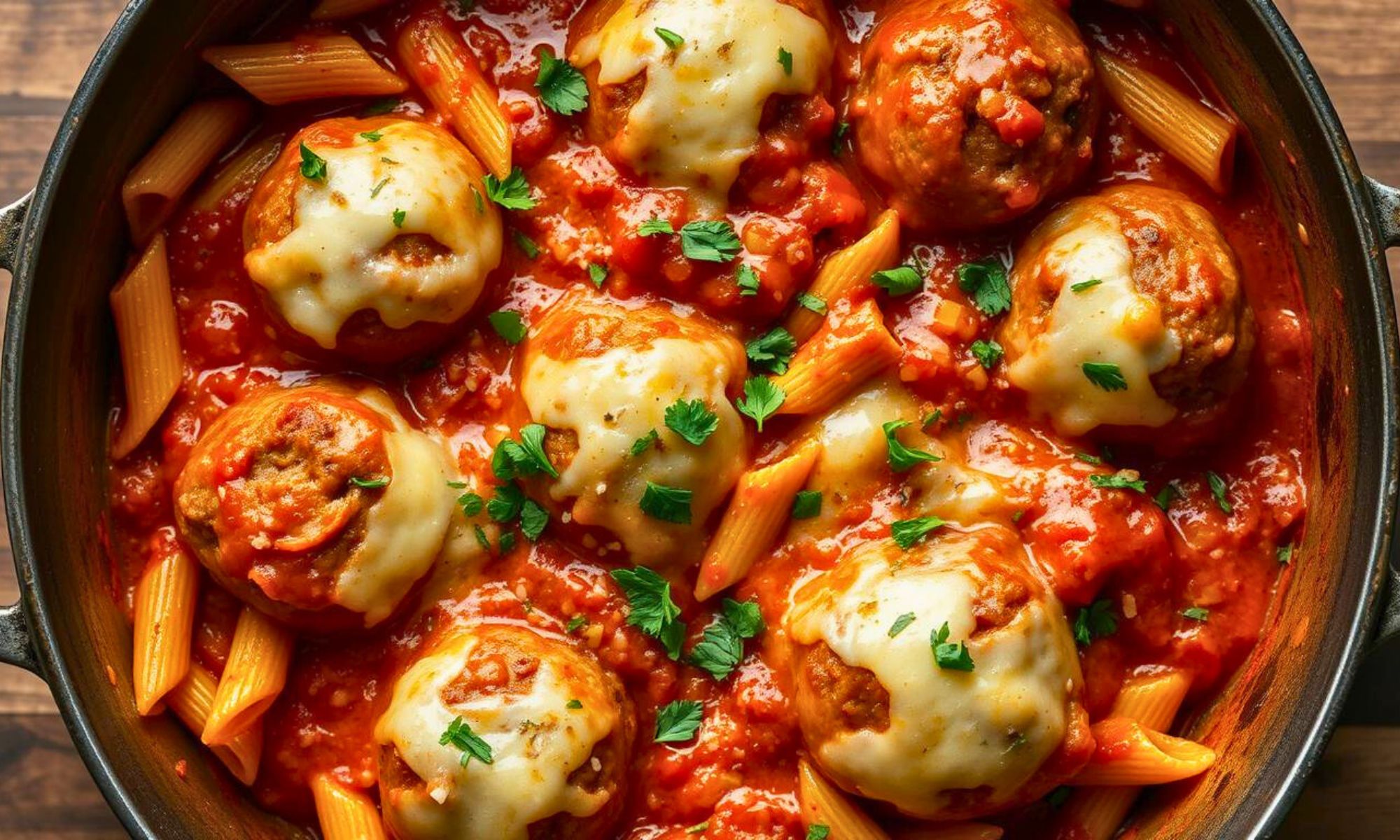What if dinner could be rich, comforting, and made with almost no cleanup? Sounds too good to be true, right? That’s exactly what you get with this Cheesy One Pan Meatball Casserole. It’s warm, cheesy, and packed with flavor yet so simple, you won’t believe it all comes together in one dish.
I remember the first time I made this casserole on a cold evening. I was tired, didn’t want to wash a mountain of dishes, and just wanted something satisfying. I threw everything into one pan meatballs, sauce, cheese and popped it in the oven. The result? Pure comfort food magic. The meatballs came out tender and the cheese? Melted to golden, bubbly perfection.
This dish is perfect for families, meal prep, or lazy weekends when you want a big, satisfying meal with minimal effort. Whether you’re a busy parent, a beginner cook, or someone who just loves cozy, oven baked goodness, this One Pan Meatball Casserole will become your go to recipe.
Ingredients & Substitutions
For the Meatballs:
- 1 pound (450g) ground beef (80/20 lean to fat ratio)
- ½ pound (225g) ground pork
- ⅔ cup breadcrumbs, preferably panko
- ¼ cup grated Parmigiano Reggiano
- 2 large eggs, lightly beaten
- 3 garlic cloves, minced or microplaned
- 2 tablespoons fresh parsley, finely chopped
- 1 tablespoon fresh basil, chiffonade (or 1 teaspoon dried)
- 1 teaspoon dried oregano
- ½ teaspoon red pepper flakes (optional)
- 1 teaspoon kosher salt
- ½ teaspoon freshly ground black pepper
- 2 tablespoons olive oil (for searing)
For the Casserole Base:
- 1 medium onion, diced
- 1 red bell pepper, diced
- 2 celery stalks, finely chopped
- 4 garlic cloves, minced
- 2 tablespoons tomato paste
- ¼ cup dry red wine (optional)
- 1 can (28 oz) crushed tomatoes
- 1 can (14 oz) diced tomatoes, undrained
- 1 teaspoon dried oregano
- 1 teaspoon dried basil
- 1 bay leaf
- ½ teaspoon sugar
- Salt and pepper to taste
For the Topping:
- 8 oz mozzarella cheese, shredded
- ¼ cup Parmigiano Reggiano, grated
- Fresh basil leaves, for garnish
Ingredient Insights & Substitutions for Cheesy One Pan Meatball Casserole
The magic of this recipe lies in its adaptability. Don’t get hung up on exactitude here cooking is about flexibility and intuition. Ground turkey or chicken can replace beef and pork for a lighter option, though you’ll wanna add a tablespoon of olive oil to compensate for the reduced fat content. Plant based alternatives work surprisingly well beyond meat or impossible products maintain that critical umami component.
For a gluten free version, swap traditional breadcrumbs with crushed rice crackers or certified gluten free breadcrumbs. The parmesan provides crucial flavor depth, but nutritional yeast offers a similar umami punch for dairy free eaters.
The wine isn’t just fancy sounding ingredients it adds crucial acidity and depth. No wine on hand? No problem. A tablespoon of balsamic vinegar mixed with 3 tablespoons of chicken stock creates a reasonable flavor proxy.
The ratio of beef to pork isn’t arbitrary. Beef delivers robust flavor while pork brings unctuousness and tenderness. This balance creates meatballs that hold their shape yet remain deliciously succulent. If using leaner meats like turkey, consider adding a tablespoon of ricotta to maintain moisture.
Step-by-Step Instructions for Cheesy One Pan Meatball Casserole

Preparing the Meatballs:
- Combine all meatball ingredients except olive oil in a large bowl. Using clean hands, gently mix until just combined, overmixing leads to tough, dense meatballs. The mixture should feel cohesive but still light.
- With lightly dampened hands (prevents sticking), portion mixture into golf ball sized spheres, approximately 1½ inches in diameter. You should get about 20-24 meatballs. Place them on a plate and refrigerate for 15-20 minutes to firm up. This brief chill helps them maintain structural integrity during searing.
- Preheat your oven to 375°F (190°C). Meanwhile, heat olive oil in a large, oven safe skillet or Dutch oven over medium high heat. Working in batches to avoid crowding, sear meatballs on all sides until golden brown, about 1-2 minutes per side. They shouldn’t be cooked through just beautifully caramelized. Transfer to a paper towel lined plate.
Pro tip: A cast iron skillet works magnificently here it transitions seamlessly from stovetop to oven and provides unparalleled heat retention. If you notice excessive sticking, you’re probably turning the meatballs too soon. They’ll naturally release when a proper crust forms.
Building the Casserole:
- In the same pan with the rendered fat (liquid gold for flavor!), add diced onion, bell pepper, and celery. Sauté until vegetables soften, about 5-7 minutes. Add minced garlic and cook for another 30 seconds until fragrant. Resist the urge to rush this step these aromatics form your flavor foundation.
- Add tomato paste and cook, stirring constantly, for 2 minutes until it darkens slightly and sticks to the pan a bit. This brief caramelization transforms raw tomato flavor into something deeply complex. Deglaze with wine if using, scraping up those gorgeous browned bits from the pan bottom, that’s where all the flavor hides!
- Pour in crushed and diced tomatoes, herbs, bay leaf, and sugar. Bring to a gentle simmer, then reduce heat to medium low and cook for 10 minutes to allow flavors to meld. Season sauce with salt and pepper to taste.
- Nestle the seared meatballs into the sauce, partially submerging them. The exposed tops will develop a beautiful crust while the submerged portions absorb sauce flavors the best of both worlds!
- Sprinkle mozzarella and parmesan evenly over the top. Transfer the skillet to the preheated oven and bake uncovered for 20-25 minutes, until cheese is bubbly and golden, and meatballs register 160°F (71°C) on an instant read thermometer.
- Allow to rest for 5-10 minutes before serving. This resting period isn’t optional it allows juices to redistribute within the meatballs and prevents them from drying out. Garnish with fresh basil just before serving.
Common mistake: Overcrowding during the searing phase results in steamed rather than seared meatballs. Patience during this step pays significant dividends in the final flavor profile.
Cooking Techniques & Science
The multi dimensional flavor of this dish emerges from several key techniques. First, the Maillard reaction that complex browning process when proteins and sugars transform under heat creates dozens of new flavor compounds during the meatball searing stage. This isn’t just about appearance; it’s fundamental chemistry that delivers that characteristic “meaty” depth.
The fat rendered from the meatballs becomes a flavor vehicle for sautéing the aromatics. Vegetables contain water soluble flavor compounds, but many of their most complex notes are fat soluble. By cooking them in the rendered fat, we’re extracting maximum flavor potential.
The brief simmer of tomato paste before adding liquid undergoes a transformation chefs call “pinçage” caramelizing the sugars and concentrating the umami compounds. This technique alone elevates a standard tomato sauce to something with exceptional depth.
Temperature gradient is another critical factor. The meatballs cook differently depending on their placement in the sauce. Those deeper in the liquid cook through gentle conduction, while the exposed portions benefit from the dry, intense heat of the oven. This creates textural contrast within each meatball.
Using a heavy bottom, oven safe vessel is non negotiable here. These pans provide even heat distribution, preventing hot spots that can lead to scorching. Cast iron particularly excels because it retains heat exceptionally well, maintaining consistent temperature throughout the cooking process.
The final uncovered bake serves three purposes: it completes the meatball cooking, reduces and concentrates the sauce slightly, and creates that irresistible cheesy crust. The contrast between the crisp top layer and the saucy interior creates textural complexity that elevates this from simple comfort food to a culinary achievement.
Serving & Pairing Suggestions

Present this rustic masterpiece directly in its cooking vessel for maximum impact. The skillet’s journey from stovetop to oven to table tells a story of transformation and creates an appealingly casual, family style presentation. For more formal occasions, transfer to a pre warmed serving dish and garnish with additional fresh basil and perhaps a light drizzle of high quality extra virgin olive oil.
This casserole pairs wonderfully with crusty artisan bread for sauce mopping purposes consider a rustic ciabatta or sourdough, slightly warmed. A simple green salad dressed with lemon vinaigrette provides refreshing contrast to the rich casserole. The acidity cuts through the richness and cleanses the palate between bites.
For wine enthusiasts, embrace Italian varieties that complement the tomato acidity. A medium bodied Chianti Classico or Montepulciano d’Abruzzo enhances rather than competes with the dish’s robust flavors. If you prefer white, a Vermentino offers sufficient body and bright acidity to stand up to the intensity.
Make ahead potential adds to this dish’s versatility. You can prepare the entire casserole up to the baking stage, refrigerate for up to 24 hours, then bring to room temperature before baking. The flavors actually improve with this brief melding period, making it ideal for entertaining.
Leftovers (if any survive) transform beautifully into incredible sandwiches. Split a ciabatta roll, add sliced meatballs with sauce, top with additional cheese, and broil briefly. The result rivals any meatball sub you’ve encountered.
Wrapping Up: One Pan Meatball Casserole
One Pan Meatball Casserole represents the beautiful intersection of culinary tradition and modern practicality. The techniques employed proper searing, aromatics development, and strategic layering, create complexity belying the dish’s apparent simplicity.
What makes this One Pan Meatball Casserole truly special is its forgiving nature. The dish accommodates imperfection and substitution while delivering consistent satisfaction. It’s a perfect gateway for developing cooks to understand fundamental techniques while providing enough nuance to interest seasoned chefs.
Remember that cooking is ultimately about bringing pleasure both to those you feed and to yourself in the preparation. This One Pan Meatball Casserole, with its intoxicating aroma filling your kitchen and its ability to gather people around a table, fulfills that promise spectacularly. The integration of thoughtful technique with accessible ingredients transforms humble components into something genuinely memorable.
Frequently Asked Questions About Cheesy One Pan Meatball Casserole
Can I make the meatballs ahead of time?
Absolutely! Shape and sear the meatballs up to 2 days in advance, refrigerating them once cooled. You can even freeze the seared meatballs for up to 3 months. Thaw overnight in the refrigerator before proceeding with the recipe.
My meatballs always turn out tough. What am I doing wrong?
Three common culprits: overmixing the meat mixture, compacting the meatballs too tightly when forming them, or overcooking. Use a gentle hand throughout the process, and remember that meatballs continue cooking in the sauce after searing.
Can this recipe work in a slow cooker?
Yes, with modifications. After searing the meatballs and preparing the sauce on the stovetop, transfer both to a slow cooker and cook on low for 4-5 hours. Add the cheese during the final 30 minutes. You’ll lose some of the textural contrast, but gain convenience.
How do I prevent the cheese topping from becoming rubbery?
Use freshly shredded cheese rather than pre shredded varieties, which contain anti caking agents that affect melting properties. Also, ensure your oven is fully preheated before adding the cheese topped casserole.
Is there a good vegetarian version of this recipe?
Substitute the meatballs with plant based alternatives or make your own using a combination of mushrooms, beans, and walnuts for texture. The umami depth from mushrooms particularly complements the tomato base wonderfully.

Swiftly Captions by Tina Smith — Quick, flavorful food recipes made simple, bringing fresh inspiration to your kitchen every day






